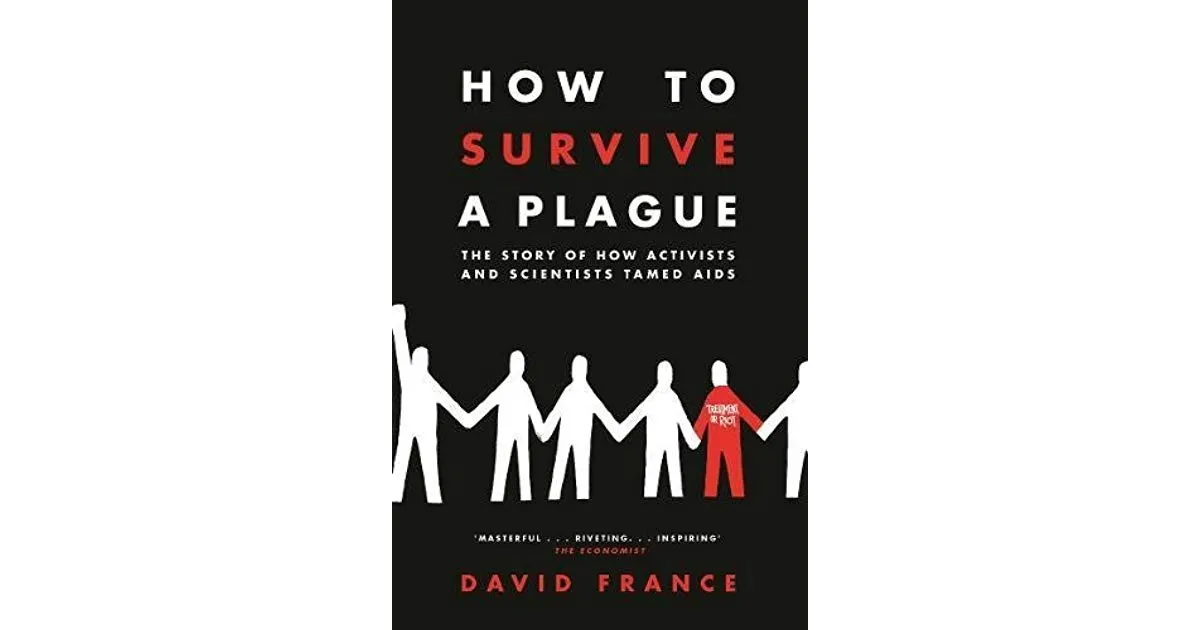The annualWellcome Book Prizecelebrates the best new fiction and non-fiction books that engage with an aspect of medicine, health or illness, and each week until the announcement of the winner on 24 April at the Wellcome Collection we will befeaturing an extractfrom the WBP2017 shortlist here onsciencefocus.com.
See the full shortlist at the bottom of this article, but before then read the prologue from author David France's powerful story about howa grass-roots movement of activists helped scientists develop the drugs and treatments that helped make themostly fatal infection a manageable disease.
Prologue - The Memorial Service
The experience of death, which had bound them together a quarter century ago, unexpectedly reunited them on an unseasonably warm January afternoon in 2013. They made their way down East Thirty-second Street in Manhattan just after two o’clock, wending sedately toward the stark black doorway of the Cutting Room, a performance space hosting the memorial service for Spencer Cox, one of the country’s most recognizable AIDS activists. Long before the glass doors swung open, a line stretched down the block. Taxicabs deposited luminaries from the worlds of science and medicine, of theater, advertising, and media, of activism, art, and academia, people from all over the United States, from Europe and Africa. Many of them were hollow cheeked and balanced on canes or on one another, slowed by age or disease or a reluctance to reenter the community of the grieving. Even the nimble among them wore haunted expressions. If you knew what to look for, you saw in their faces the burden of a shared past, the years and years of similar services. This was what survivors of the plague looked like.
The crowd swelled to five hundred. Some among them were adorned in mementos: faded protest buttons or T-shirts with militant slogans. This was the generation that fought AIDS from the dawn of the global pandemic. Most had been members or supporters of the AIDS Coalition to Unleash Power, or ACT UP—the radical protest organization that started in New York City but went on to count 148 chapters in 19 countries, with perhaps 10,000 members at its peak. The movement collapsed in the mid-1990s, when the advent of effective medicine finally staunched much of the dying. In the decades since then, it had seemed that the menace had receded, at least in America. But death convoked them once again.
Few people personified the epidemic’s long history in America more than Cox. A college dropout, he was just twenty years old when he got his grim diagnosis. Given only a few months to live, he threw himself into ACT UP, becoming a central player in the movement’s Treatment + Data Committee, where patients and their advocates puzzled through the science of virology, chemistry, and immunology. Their insights won them audiences with researchers in the deepest corridors of science—audiences, then respect, then working partnerships; it was the first time patients had joined in the search for their own salvation. Cox, a consummate networker, illustrated the developing science by submitting his own health complications to the scrutiny of reporters. In his drive to give the disease a face, he kept no aspect of his life with HIV offstage—not his rapid viral mutations, his enlarging lymph nodes, the humiliating and painful diarrhea that regularly sidelined him, or the cruel complication that turned his left eye cloudy and useless.
That was how I first met him. In the winter of 1988, he brought me his latest laboratory results to help describe how certain experimental drugs were thought to work, and how, in fact, they routinely failed. We met in a dark coffee shop late in the morning. Short and smooth faced with dark eyes and floppy black hair, he arrived Brando style in industrial work boots, jeans tight as a sunburn, and a black leather bomber jacket over a white T-shirt—the uniform of ACT UP. His youth disarmed me. He looked like a teenager, not yet able to grow a beard. But he displayed a researcher’s grasp of his own cellular tapestry and a facility for rendering complex immunological principles into everyday language. He was anything but self-pitying. Reaching into a canvas army surplus bag, he spun a sheath of his lab results across the table, accompanied by a line from Bette Davis that was lost on me. Until recently, Cox had learned much of what he knew from the movies, especially those of the 1940s and ’50s, or the theater, which had been the subject of his aborted education.
Over the ensuing years, he became a principal source for much of my AIDS reporting, and among the most effective treatment advocates in the field. But his seminal achievement came in the area of biostatistics. It was Cox who conceived the drug trial innovations that in record time helped to bring to market the therapies that stopped HIV from being an automatic death sentence. He claimed no credit for this, and until shortly before his death only a few insiders were aware that a self-taught person with AIDS—by training an actor—had made this history-changing contribution.
Since that stunning breakthrough in 1996, the new treatments had reached millions of people worldwide, returning to them the promise of a near-normal life-span. Some had been just breaths away from their own deaths. But after a few weeks on treatment they rose from their hospital beds and, against all reasonable expectation, went home to resume an ordinary life. So dramatic was their resurrection that stupefied doctors began calling it the Lazarus effect.
And yet the pharmaceutical marvels Cox fought so hard to bring into existence failed him in the end. His infection proved to be resistant to many drug combinations. The country’s best doctors tinkered with “salvage” regimens specifically for him, accomplishing numerous barely-in-time rescues. For over half his life Cox careened from one medical trauma to another, maintaining his darkly comic facade, though in recent years he had grown weary. The last time I saw him he spoke of feeling run-down. When he checked into the hospital a few weeks later, his viral load was overbearing and his T-cell count, which had been in the healthy range, had sunk to just thirty, putting him at risk for a host of fatal infections. Doctors diagnosed hypoglycemia and severe pneumonia. By the following Tuesday, forty-four years old but wracked and worn as a guerrilla commandant, he died from multiple complications of AIDS.
So went the global AIDS pandemic in its fourth decade. A precise number of the dead can’t be fixed, as the majority have fallen in areas of sub-Saharan Africa unknown to doctors or census takers. At the time of Cox’s death, the body count was as high as forty million, which is nearly twice the devastation of the bubonic plague that threatened humankind in the fourteenth century. In the United States, the official count was 658,507 dead by the end of 2012—an approximate figure, despite its ring of precision. In the early years especially, many people were declared dead from other causes in order to spare the relatives from stigma or because doctors mistook the symptoms. Or the deceased went down as suicide statistics instead, having chosen pills or bullets or the high-rise window over the inevitable.
Though so much has changed, so much is still the same. Around the globe two million people still die from AIDS every year because the cost of the effective medicines—under a dollar a day—is prohibitive. In America, where the price is fifty times higher, a federal law provided the treatment to indigent patients since 1987, adopted under intense lobbying by gay leaders, though access to the medicine was spotty nonetheless, because a prescription was required and many could not afford to visit a doctor. The year Cox died, 13,711 other Americans were claimed by AIDS. As in the epidemic’s very first year, most belonged to communities that were stigmatized, marginalized, feared, or hated. Cox had begun his journey through the plague as a gay man at a time when most Americans supported laws criminalizing homosexuality. He finished his life entirely dependent upon social services for his day-to-day living, and on probation for a criminal conviction after a descent into common drug addiction.
Few of his old colleagues knew about Cox’s last days. The members of ACT UP had drifted far apart in recent years. Even Cox’s old HIV-positive support group, men who had relied upon one another in the way one does in wartime and made a blood vow to be at one another’s side when the time came, scattered once AIDS went from a mostly fatal disease to a condition that could for the most part be managed. “When we realized we weren’t going to die,” said David Barr, who convened the support group, “instead we all got sick of each other.”
That could not have been foreseen at the support group’s height. In the epic struggle for survival that consumed the plague years, these men—Barr, an attorney by training; Peter Staley, a former bond trader; Gregg Bordowitz, an experimental filmmaker; Derek Link, a onetime bookstore clerk; Mark Harrington, a film archivist—were among the recognized generals, the architects and administrators of the movement’s public health strategy. Successive presidential administrations sought their insights, and Nobel Prize winners adopted their critiques. Global pharmaceutical companies succumbed to their demands, at first out of fear of guerrilla protests and later out of respect for their minds. Embracing their reputations for arrogance, insolence, and prominence, they had jokingly called themselves “the HIVIPs.” That anyone with HIV had a chance for an ordinary life was thanks to the work they did.

The full 2017 Wellcome Book Prize shortlist is:
- How to Survive a PlaguebyDavid France(USA)Picador, Pan Macmillan
- When Breath Becomes AirbyPaul Kalanithi(USA)The Bodley Head, Penguin Random House
- Mend the LivingbyMaylis de Kerangal(France) trans.Jessica MooreMacLehose Press
- The Tidal ZonebySarah Moss(UK)Granta Books
- The GenebySiddhartha Mukherjee(USA)The Bodley Head, Penguin Random House
- I Contain MultitudesbyEd Yong(UK)The Bodley Head, Penguin Random House

